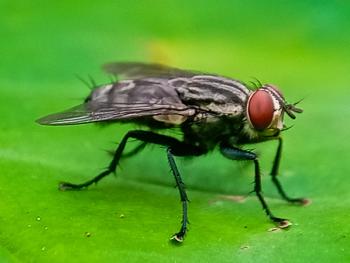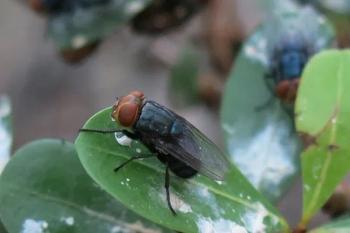
Clinical parasitology: Fact from fiction, science from salesmanship (Proceedings)
Experimental studies conducted at Auburn University have shown that an acute respiratory crisis often diagnosed as asthma may occur during either Stage (Phase) 1 or 2 feline heartworm disease.
Heartworm Testing in Dogs
• Antigen tests detect D. immitis female uterine antigen.
• Antigenemia and microfilaremia appear for the first time about 5 and 6.5 months post-infection, respectively.
• Approx 10% of dogs AG+ by 5 months; >95% by 7 months
• Antigenemia may precede, but often lags the appearance of microfilariae, by a few weeks.
• At between 5.5 and 6.5 months a dog may be microfilariae positive before becoming antigen positive.
• According to the AHS, AAHA and CAPC, heartworm testing should be conducted annually irregardless of seasonal or continual administration.
• If dog is on a monthly macrolide preventive then annual testing can only be conducted using an antigen test.
• All macrolide preventives, kill microfilariae and sterilize female heart worms.
• But they do not affect antigen production
Feline Heartworm Disease: Heartworm Associated Respiratory Disease
• Experimental studies conducted at Auburn University have shown that an acute respiratory crisis often diagnosed as asthma may occur during either Stage (Phase) 1 or 2 feline heartworm disease.
• The American Association of Feline Practitioners and the American Heartworm Society have suggested the name of this disease in cats be changed to Heartworm Associated Respiratory Disease. This change was introduced at the 2007 NAVC and is meant to reinforce the fact that Dirofilaria infection in cats is primarily a respiratory disease.
• Stage or Phase 1 HARD often occurs 3 – 6 months post infection as small migratory L5 (2 – 5cm) arrive in the lungs as early as 90 - 100 days after being infected by a mosquito. Lung responds with intense inflammation and "asthma- like" symptoms may develop. Type II cell hyperplasia and activation of a specialized macrophage, pulmonary intravascular macrophage (PIM), (designed to envelop and digest foreign materials) in the capillary beds of the lung that are not present in the dog. An important note here is that cats can become extremely ill and even die without adult heartworms ever developing.
• After the mature parasite develops, the clinical signs may be intermittent or absent
• The living adult worm seems to be able to suppress the immune function.
• Stage or Phase 2 HARD occurs 1 – 2 years post infection once the heartworm dies. At time of worm death, the lung become extremely inflamed and the PIM become key players in the intense reaction. The result is a non-functioning lung and an acute respiratory distress syndrome. This reaction can occur as the result of even a single worm dieing.
• Diagnosis of HARD in cats is often based on a combination of diagnostic tests (antigen or antibody, CBC, chest radiographs, ultrasound, clinical signs etc.). Serological Tests: There are 2 serologic methods (antigen and antibody) which are useful for feline heartworm disease. Rapid advances are constantly changing these assays.
• Antibody Testing: (specific for cats – detecting AB produced by cats). Antibody detected is produced by the cat in response to the early migration (molting) of the L3 or L4 larvae, positive titers are detected about 1 - 3 months after an infection. Approximately 80% of cats AB positive by 2 months, 97-100% of cats AB positive by 3 months and almost 100% of cats AB positive by 4 months. Only patient side AB test at this time is the Solo Step FH (serum, plasma or whole blood: Heska).
• Antigen Testing: (canine heartworm antigen tests may be used in cats). As in dogs antigen tests are virtually 100% specific. However, in cats these tests will not detect all infections (false negative results have occurred in necropsy studies at the rate of 7 – 64% in cats). Remember that the antigen detected by these tests is female heartworm uterine antigen. Female heartworms need to develop to maturity to produce the antigen.
• False negatives occur in cats because of immature infections, low worm burdens or from all male infections. Current tests can not detect male worms. Cats may develop positive antigen tests as early as 6 months P.I., but typically later. The low number and slow maturation of adult worms in clinical infections and the clinical signs associated with immature worms make it prudent: to consider a positive antigen test diagnostic, but do not rule out heartworms based on a negative antigen test. Patient side antigen test for cats by IDEXX.
• FDA approved heartworm preventive(s) in cats?
o Selamectin (6-12 mg/kg; topically) is the same in both cats and dogs.
o Ivermectin (24 µg/kg orally), four times the minimum recommended dose in dogs.
o Milbemycin oxime (2.0 mg/kg orally), four times the minimum recommended dose in dogs.
o Imidacloprid/moxidectin (Bayer Animal Health; 10 mg/kg imidacloprid/1.0 mg/kg moxidectin [cats]). As of January 2007 not registered in the U.S. Currently registered in Canada as Advantage Multi and in Europe and Australia as Advocate.
Giardiasis
• Giardia is one of the most commonly misdiagnosed, under-diagnosed and over-diagnosed parasitic diseases.
• Many veterinary practices are unable to identify Giardia cysts or trophozoites.
• Microscopes are not equipped with micrometers that can allow measurement of cysts
• Veterinarians have relied on response to treatment (metronidazole) as a diagnosis
• Fecal exams are often conducted using passive flotation systems with various solutions other than zinc sulfate.
• Excretion of Giardia sp. cysts is intermittent
• Results from several wet labs indicate that even when told a sample is positive for Giardia, technicians and veterinarians have difficulty finding and correctly identifying Giardia cysts.
• Giardia Treatment
Dogs:
• Fenbendazole; 50mg/kg PO SID for 3 days
• Drontal Plus (Praziquantel,Pyrantel pamoate, Febantel); 5.4 to 7mg/kg SID for 3 days
• Metronidazole (FlagylR) - 25 mg/kg P.O. BID x 5 days
o Side effects (neurological toxicity; ataxia, seizures, weakness etc.
o Resistance common
o Not approved for any use in animals
o Antispasmotic, anti-inflammatory, antibacterial – used to treat colitis.
• Bath animals on day of last treatment. (Removal of cysts from hair and skin)
• Control also involves prevention of fecal contamination of feed and water and disinfection (1% chlorine bleach).
Cats:
• Fenbendazole as for dogs
• Drontal Plus as for dogs
• Metronidazole - 25 mg/kg b.i.d. x 7 days or 50mg/kg s.i.d x 5 days
Suggested web sites and references:
Bowman DD, D.G. Stansfield, J.H. Thoren The Efficacy of Milbemycin Oxime/lufenuron and Selamectin in Treating Adult Intestinal Nematodes (Ancylostoma caninum, Toxocara canis, and Trichuris vulpis)., AAVP 2000 annual Meeting.
Browne LE, Carter TD, Levy JK, Snyder PS, Johnson CM. Pulmonary arterial disease in cats seropositive for Dirofilaria immitis but lacking adult heartworms in the heart and lungs. Am J Vet Res. 2005 66(9):1544-1549.
Dryden MW, Payne PA, Ridley R, Smith V. Comparison of common fecal flotation techniques for the recovery of parasite eggs and oocysts. Vet Therapeutics 6(1), 14 – 28, 2005.
Dryden MW, Payne PA, Ridley RK, Smith VE. Gastrointestinal Parasites: The Practice Guide to Accurate Diagnosis and Treatment. Supplement to Compendium: Continuing Education for Veterinarians. 28(8A):3 – 14, 2006
Fukase T, In T, Chinone S, Akihama S, Itagaki H. Anthelmintic efficacy of milbemycin D against Toxocara cati and Ancylostoma tubaeforme in domestic cats. J Vet Med Sci. 1991 Oct;53(5):817-21.
McTier TL, Shanks DJ, Wren JA, Six RH, Bowman DD, McCall JW, Pengo G, Genchi C, Smothers CD, Rowan TG, Jernigan AD. Efficacy of selamectin against experimentally induced and naturally acquired infections of Toxocara cati and Ancylostoma tubaeforme in cats. Vet Parasitol. 2000 Aug 23;91(3-4):311-9.
Reinemeyer CR, Faulkner CT, Assadi-Rad AM, Burr JH, Patton S. Comparison of the efficacies of three heartworm preventives against experimentally induced infections with Ancylostoma caninum and Toxocara canis in pups. J Am Vet Med Assoc. 1995 Jun 1;206(11):1710-5.
Newsletter
From exam room tips to practice management insights, get trusted veterinary news delivered straight to your inbox—subscribe to dvm360.






